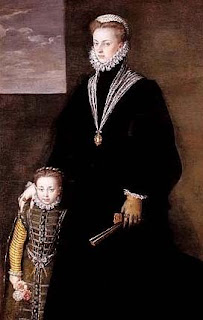On Christmas Day in 1545 three women took Jesuit vows: Isabel Roser, a Spanish noblewoman; her lady-in-waiting Francisca Cruyllas; and Isabel’s friend Lucrezia di Bradine. The order founded by St. Ignatius Loyola was only five years old, and Isabel had been one of its biggest benefactors from the start. But Ignatius wasn’t willing to grant her request for membership, and she used her influence with Pope Paul III to force his hand. Still, the status of the women wasn’t clear: were they nuns? a third order? A few months later, Ignatius got the pope to dispense them from their vows. In 1547 he got a papal brief forbidding the Jesuits from taking on a women’s branch. A few years later, though, another woman wanted to join: the Archduchess Juana of Austria (1535-1573), daughter of Austria’s Emperor Charles V and sister of Spain’s King Philip II. When Philip left for England to marry Queen Mary (a.k.a. “Bloody Mary”), he appointed Juana to run the country in his absence. During that time, she approached the Jesuits about her joining. This request put them in a tough spot. Saying no might alienate Spain’s ruler, and who knew what that would mean for the Spanish Jesuits? When they finally granted her request, she was enjoined to absolute secrecy. Jesuit historian John Padberg notes that the “secret was so well kept that no one ever suspected it. And as far as is known today, Juana lived the rest of her rather short life… as the only woman Jesuit.”












